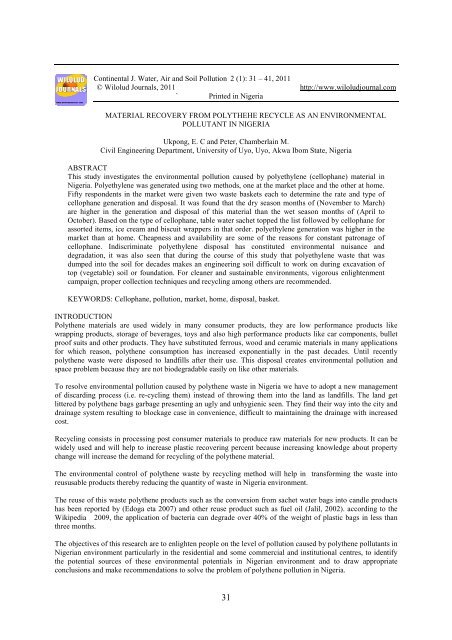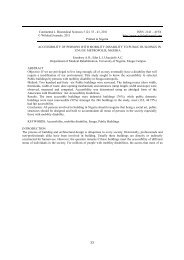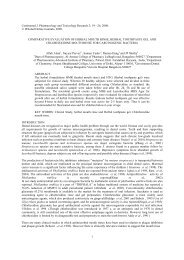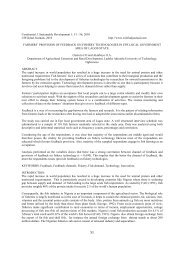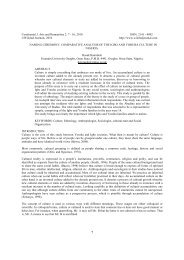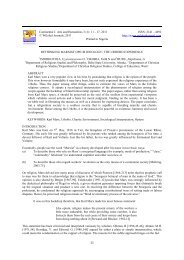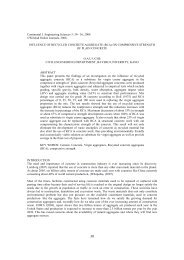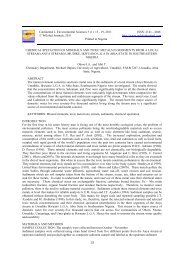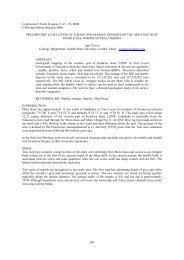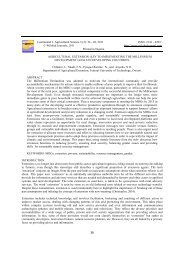Vol 2 _1_ - Cont. J Water, Air and Soil Pollution - Wilolud Journals
Vol 2 _1_ - Cont. J Water, Air and Soil Pollution - Wilolud Journals
Vol 2 _1_ - Cont. J Water, Air and Soil Pollution - Wilolud Journals
You also want an ePaper? Increase the reach of your titles
YUMPU automatically turns print PDFs into web optimized ePapers that Google loves.
<strong>Cont</strong>inental J. <strong>Water</strong>, <strong>Air</strong> <strong>and</strong> <strong>Soil</strong> <strong>Pollution</strong> 2 (1): 31 – 41, 2011© <strong>Wilolud</strong> <strong>Journals</strong>, 2011 http://www.wiloludjournal.com` Printed in NigeriaMATERIAL RECOVERY FROM POLYTHEHE RECYCLE AS AN ENVIRONMENTALPOLLUTANT IN NIGERIAUkpong, E. C <strong>and</strong> Peter, Chamberlain M.Civil Engineering Department, University of Uyo, Uyo, Akwa Ibom State, NigeriaABSTRACTThis study investigates the environmental pollution caused by polyethylene (cellophane) material inNigeria. Polyethylene was generated using two methods, one at the market place <strong>and</strong> the other at home.Fifty respondents in the market were given two waste baskets each to determine the rate <strong>and</strong> type ofcellophane generation <strong>and</strong> disposal. It was found that the dry season months of (November to March)are higher in the generation <strong>and</strong> disposal of this material than the wet season months of (April toOctober). Based on the type of cellophane, table water sachet topped the list followed by cellophane forassorted items, ice cream <strong>and</strong> biscuit wrappers in that order. polyethylene generation was higher in themarket than at home. Cheapness <strong>and</strong> availability are some of the reasons for constant patronage ofcellophane. Indiscriminate polyethylene disposal has constituted environmental nuisance <strong>and</strong>degradation, it was also seen that during the course of this study that polyethylene waste that wasdumped into the soil for decades makes an engineering soil difficult to work on during excavation oftop (vegetable) soil or foundation. For cleaner <strong>and</strong> sustainable environments, vigorous enlightenmentcampaign, proper collection techniques <strong>and</strong> recycling among others are recommended.KEYWORDS: Cellophane, pollution, market, home, disposal, basket.INTRODUCTIONPolythene materials are used widely in many consumer products, they are low performance products likewrapping products, storage of beverages, toys <strong>and</strong> also high performance products like car components, bulletproof suits <strong>and</strong> other products. They have substituted ferrous, wood <strong>and</strong> ceramic materials in many applicationsfor which reason, polythene consumption has increased exponentially in the past decades. Until recentlypolythene waste were disposed to l<strong>and</strong>fills after their use. This disposal creates environmental pollution <strong>and</strong>space problem because they are not biodegradable easily on like other materials.To resolve environmental pollution caused by polythene waste in Nigeria we have to adopt a new managementof discarding process (i.e. re-cycling them) instead of throwing them into the l<strong>and</strong> as l<strong>and</strong>fills. The l<strong>and</strong> getlittered by polythene bags garbage presenting an ugly <strong>and</strong> unhygienic seen. They find their way into the city <strong>and</strong>drainage system resulting to blockage case in convenience, difficult to maintaining the drainage with increasedcost.Recycling consists in processing post consumer materials to produce raw materials for new products. It can bewidely used <strong>and</strong> will help to increase plastic recovering percent because increasing knowledge about propertychange will increase the dem<strong>and</strong> for recycling of the polythene material.The environmental control of polythene waste by recycling method will help in transforming the waste intoreususable products thereby reducing the quantity of waste in Nigeria environment.The reuse of this waste polythene products such as the conversion from sachet water bags into c<strong>and</strong>le productshas been reported by (Edoga eta 2007) <strong>and</strong> other reuse product such as fuel oil (Jalil, 2002). according to theWikipedia 2009, the application of bacteria can degrade over 40% of the weight of plastic bags in less thanthree months.The objectives of this research are to enlighten people on the level of pollution caused by polythene pollutants inNigerian environment particularly in the residential <strong>and</strong> some commercial <strong>and</strong> institutional centres, to identifythe potential sources of these environmental potentials in Nigerian environment <strong>and</strong> to draw appropriateconclusions <strong>and</strong> make recommendations to solve the problem of polythene pollution in Nigeria.31
Ukpong, E. C <strong>and</strong> Peter, Chamberlain M <strong>Cont</strong>inental J. <strong>Water</strong>, <strong>Air</strong> <strong>and</strong> <strong>Soil</strong> <strong>Pollution</strong> 2 (1): 31 – 41, 2011This work will help to assess the levels of pollution caused by polythene waste which produces poisonous gas tothe environment (l<strong>and</strong>, water <strong>and</strong> air) when burnt, for example carbon monoxide (Co) is introduced into theatmosphere as a result of polythene burning. It will also see polythene waste not only as a pollutant but also as araw material for the production of plastic <strong>and</strong> insulation cable for electrical equipments <strong>and</strong> vehicle parts.Polythene materials are those materials made from a chemical compound known as polyethylene (C-H) n <strong>and</strong> ismanufactured from the polymerization of ethylene (C-H) as represented in Figure 1. Basically, polyethylene isan odorless, translucent solid, commercially available in pellet form which is convertible to derivative productssuch as the polythene bags. Pep is stable <strong>and</strong> inert polymers, exhibiting very high resistance to chemical attack.HHHHFigure 1: Polyethylene structurePOLLUTION CAUSED BY POLYTHENE WASTEEnvironmental pollution created by polythene includes soil, water <strong>and</strong> air contamination <strong>and</strong> blocking of drains<strong>and</strong> sewage lines in <strong>and</strong> around cities. Since polythene is non-degradable, it remains intact in water <strong>and</strong> soil formany years; <strong>and</strong> are not productive to the soil as reported by Aziegbe (2007) <strong>and</strong> federal environmentalprotection agency (FEPA) (1998) <strong>and</strong> Luwig (1990) <strong>and</strong> Ibanga (2000) Sharma <strong>and</strong> Kanwar 2007). Adverseeffects on livestock have also been reported (Mohammed <strong>and</strong> Muhammed 2007). Open burning of refuse dumpsin developing countries is a common practice (Izugbara <strong>and</strong> Umoh 2004). It has been realized that if burnedpolythene products, it produce harmful toxins which can threaten air quality (UNEP 2002; Sharma <strong>and</strong> Kanwar2007). Some of the toxic substances release include pops such as hazardous dioxins (UNEP 2002) otherthermal/oxidative degradation products of the polythene in controlled condition have been studied <strong>and</strong> consistsof chemical that are harmful to human health <strong>and</strong> area of environmental concern (Sojak etal, 2006).The environmental pollutants are those materials that cause pollution to our environment, which may beclassified as air, water or l<strong>and</strong> pollutants which polythene belong. These pollutants may be degradable or nondegradable<strong>and</strong> can be found in drainages. They introduce contaminants into the environment that causesinstability, disorder, harm or discomfort to the ecosystem. They also cause delayed flowering in plants, sciencedaily .CLASSIFICATION OF POLYTHENEPolythene material is classified into several different categories based mostly on its density <strong>and</strong> branching. Themechanical properties of polythene depend significantly on variables such as the extent <strong>and</strong> type of branching,the crystal structure <strong>and</strong> the molecular weight, with regard to solid volumes, the most important polythenegrades are HDPE, LLDPE <strong>and</strong> LDPE (Wikipedia, 2009).The surface of the earth where man spends his entire life has undergone drastic changes arising from main’sintervention in many natural processes. Polythene waste is the unwanted discarded over used polythene products<strong>and</strong> they remain as waste in the environment. They constitute the acids, chemicals, oils <strong>and</strong> grease, total32
Ukpong, E. C <strong>and</strong> Peter, Chamberlain M <strong>Cont</strong>inental J. <strong>Water</strong>, <strong>Air</strong> <strong>and</strong> <strong>Soil</strong> <strong>Pollution</strong> 2 (1): 31 – 41, 2011suspended solids, total dissolve solids, heavy metals ions, mercaptans, packaging materials, polyolefins,polystyrene for packaging electronic materials, radio <strong>and</strong> television sets.Of all classes of wastes, polythene waste posses the greatest threat to life, because it has the potential ofpolluting l<strong>and</strong>, water <strong>and</strong> air using water <strong>and</strong> air as transport media. <strong>Air</strong> pollution is one of the manyenvironmental problems posed to man from his surroundings. It is the presence of substances or contaminants inthe outdoor atmosphere in concentration large enough to be injurious to human, plants <strong>and</strong> animal life. <strong>Air</strong>pollution is caused by both natural <strong>and</strong> artificial means of introducing gasses or particulate substances(contaminants) into the atmosphere. The composition of air reveals some of the pollutants in the atmosphere.Polythene waste affects the environment by degradation to produce poisonous gases which is harmful to theenvironment. For example PVC can degrade to Hcl gas which is poisonous <strong>and</strong> when in contact with flame incase of bush burning can produce gas which is poisonous to man (Aziegbe, F. I., 2007).<strong>Water</strong> is very essential to plant <strong>and</strong> animal lives. It is being polluted as a result of the introduction of polythenewaste in form of gases, liquid (sludge) <strong>and</strong> solid into a body of water which affects both the surface <strong>and</strong>underground water. Polythene waste destabilizes the characteristics of water <strong>and</strong> affects its temperature, taste,odour, colour, turbidity, amount of suspended solids (ss), <strong>and</strong> electrical conductivity of water. It has also beenobserved that fish <strong>and</strong> other marine species in the water ways misunderst<strong>and</strong>ing polythene material as fooditems, swallow them <strong>and</strong> die (West, 2006).L<strong>and</strong>s are being polluted as a result of indiscriminate dumping of polythene waste. Many materialsmanufactured from polythene, example slippers, plastic shoes, chairs, toys are discarded when they are spoiled<strong>and</strong> this constitutes polythene waste. These polythene wastes apart from reducing the aesthetic value of l<strong>and</strong> canalso degrade to produce simple chemicals which may be poisonous <strong>and</strong> harmful to health, thus the damage doneto the environment by polythene waste can be reduced through minimization of waste production, suitablemeans of waste disposal, recovery, conversion, control <strong>and</strong> reuse (Olanrewaju <strong>and</strong> Ilemobade, 2009).EFFECT OF POLYTHENE WASTE ON ENGINEERING SOILDuring construction of houses or drainages there is a necessary dem<strong>and</strong> for the excavation of the entire areaneeded for sub-structure (foundation), in the case of road construction cutting of the vegetable soil which is nota good engineering soil is required. In this study it was found that during this excavation the area wherepolythene waste are buried long before the job is to be done tends to pose more difficulty in excavation becauseof its chemical constituents present in the polythene material which hardens the soil when decomposed.Polythene waste does not allow for a complete compaction <strong>and</strong> consolidation of the soil which then reduces thebearing <strong>and</strong> shearing strength of that particular soil according to (Awomeso, <strong>and</strong> Taiwo, (2010). EnvironmentalScience Publications, 2010 <strong>and</strong> (Sybil 1997)RESEARCH METHODOLOGYMATERIALS RECOVERYTwo major approaches were adopted in acquiring the data used for this study. A daily market namely; AkpanAndem market was selected for data collection. Two areas measuring 10 meters by 30 meters were demarcatedin such a manner that one was the raw food section <strong>and</strong> the other in the processed food items (provision stores)section. In the market one of the sanitation personnel was made to sweep the demarcated areas daily <strong>and</strong> wasinstructed to always select the cellophane from other wastes. These were stored in special refuse collection bins<strong>and</strong> were measured weekly. And because it is also within the scope of this study to determine <strong>and</strong> compare theamount of cellophane generated at homes <strong>and</strong> in the market, 100 waste paper baskets were distributed to 50respondents approached previously to participate in this study. Each participant was given two waste paperbaskets, while one of these baskets was to be placed <strong>and</strong> monitored in the market, the other is to be used athomes. Data were collected on weekly basis in the month of July <strong>and</strong> November 2010. The data were analyzedusing percentage <strong>and</strong> bar charts. However this study concentrated only in the market <strong>and</strong> at homes because theseareas are the major generating <strong>and</strong> disposal points.33
Ukpong, E. C <strong>and</strong> Peter, Chamberlain M <strong>Cont</strong>inental J. <strong>Water</strong>, <strong>Air</strong> <strong>and</strong> <strong>Soil</strong> <strong>Pollution</strong> 2 (1): 31 – 41, 2011Methods of Recycling PolytheneThe following procedures of recycling polythene materials were adopted;(i) Inspection – polythene wastes are inspected for contaminants such as rock <strong>and</strong> glass <strong>and</strong> for materialsthat the plant cannot recycle.(ii) Chopping <strong>and</strong> washing – the polythene wastes are washed <strong>and</strong> chopped into flakes using the washingmachine as shown in Figure 1.Fig. 1: Washing Machine(iii)Flotation tank – If mixed polythene are being recycled, they are sorted in flotation tank, where sometypes of polythene sink <strong>and</strong> other float. The floatation units are shown in Figure 2a <strong>and</strong> Fig 2brespectively.Fig. 2(a) Floatation Unit Fig. 2 (b) Floatation Unit(iv)Drying – The polythene flakes are then dried in a tumble drier as in Figure3.34
Ukpong, E. C <strong>and</strong> Peter, Chamberlain M <strong>Cont</strong>inental J. <strong>Water</strong>, <strong>Air</strong> <strong>and</strong> <strong>Soil</strong> <strong>Pollution</strong> 2 (1): 31 – 41, 2011Fig. 3: Drying Machine(v)Melting – The dried flakes are fed into an extruder where heat <strong>and</strong> pressure melt the polythene. Theextruding machine is shown in Figure 4. Different types of plastic melt at different temperatures.Fig. 4: Extruding Machine(vi)(vii)Filtering – The molten polythene is forced through a fine screen to remove any contaminants thatslipped through the washing process. The molten plastic is then formed into str<strong>and</strong>s.Pelletizing – The str<strong>and</strong>s are then cooled in water, using the cooling bay as in Figure 5, then they arechopped into uniform pellets using the palletizing machine shown in Figure 6a, <strong>and</strong> the manufacturingcompanies buy the plastic pellet from recyclers to make new products as in Figure 6b.35
Ukpong, E. C <strong>and</strong> Peter, Chamberlain M <strong>Cont</strong>inental J. <strong>Water</strong>, <strong>Air</strong> <strong>and</strong> <strong>Soil</strong> <strong>Pollution</strong> 2 (1): 31 – 41, 2011Fig. 5: Cooling BayFig. 6 (a): Pelletizing MachineFig. 6 (b): Pelletized ProductRESULTS AND DISCUSSIONThe polyethylene collected were sorted <strong>and</strong> counted. The result shows that table water sachet topped the list,following that order of descending magnitude is ice cream <strong>and</strong> biscuit wrapper (Table 2). Table water sachettopped the list because; it is consumed throughout the year with a very little seasonal variation, Again, thestudied markets have no public portable water system where the traders can get their drinking water. As a result,majority of them depend on the sachet water on a daily basis. Some traders who take their drinking water to themarket from home soon discover that the water becomes too worm <strong>and</strong> unfit for consumption in the afternoonsparticularly on dry season.Consequently, they resort to the cold sachet water that is being hawked all over the market. Ice cream wrappersexhibited the highest variation in this study. Their generation <strong>and</strong> disposal are readily compared both during thedry months <strong>and</strong> the heart of the wet season. Polyethylene for assorted items also exhibited high seasonalvariation. This implies that its dem<strong>and</strong> <strong>and</strong> consumption is almost uniform throughout the year. Arup etal,(2006) reported similar finding for Ibadan. She noted that among the non-biodegradable solid waste generated,cellophane is mostly affected by seasonality. Types of cellophane generation at home <strong>and</strong> market also displayeda very interesting pattern (Table 1a <strong>and</strong> 1b).Table 1a: Show polyethene generated at Homes <strong>and</strong> Market during dry season month of November 2010Place / Types Assorted Biscuit wrappers Ice cream Pure water sachetsachetsMarket (kg)/week 28,050 33,475 44,859 52,998%dry at the market 9.9 11.55 15.4 18.15Homes (kg)/week 54,099 24,895 19,533 13,948% dry at homes 26.96 12.1 9.35 6.636
Ukpong, E. C <strong>and</strong> Peter, Chamberlain M <strong>Cont</strong>inental J. <strong>Water</strong>, <strong>Air</strong> <strong>and</strong> <strong>Soil</strong> <strong>Pollution</strong> 2 (1): 31 – 41, 2011Fig. 7a: Bar Chart showing polyethene waste generated at homes <strong>and</strong> market during dry season month, Nov.2010.Table 1b: Show polythene generated at homes <strong>and</strong> market during wet season month of July, 2010Place / Types Assorted Biscuit wrappers Ice cream sachets Pure water sachetMarket (kg)/week 22,950 27,388 36,703 43,362% wet at the market 8.1 9.45 12.6 14.85Homes (kg)/week 44,262 20,368 15,981 11.412% wet at homes 22.05 9.9 7.65 5.4Fig. 7b:Bar Chart showing polyethene waste generated at homes <strong>and</strong> market during wet seasonmonth, July 2010In ascending order, it shows that polyethylene for assort items was the least (51,000 kg), followed by biscuit(56,865kg), ice cream sachets (81,526kg) <strong>and</strong> table water sachets (96,361kg) in the market. At home, the trenddisplayed, when arranged in closely followed by biscuit wrapper (45,263kg), ice cream wrappers (35,514kg)<strong>and</strong> table water sachets (25,360kg). Cellophane for assorted items ranked lowest in the market because they areused in wrapping items in the market but disposed off at home having removed the contained items for cookingor storage. The generation of table water sachet was lowest at home but highest in the market. This is so becausemost homes have refrigerator where they can store water for it to get cool/cold.The findings is in agreement with Ibanga (2000) study in Yola, Northern Nigeria, where he reported that coolsachet water <strong>and</strong> ice cream are sold more at markets <strong>and</strong> schools. The mean number of individual polyethylenegenerated was also examined.37
Ukpong, E. C <strong>and</strong> Peter, Chamberlain M <strong>Cont</strong>inental J. <strong>Water</strong>, <strong>Air</strong> <strong>and</strong> <strong>Soil</strong> <strong>Pollution</strong> 2 (1): 31 – 41, 20112).Further analysis showed that an individual generated <strong>and</strong> disposed 0.665kg of cellophane daily (TableTable 2: Measured <strong>and</strong> estimated amount of polyethylene generated by individual in Uyo, Akwa Ibom State <strong>and</strong>NigeriaCategory Estimated population (m) No. of polyethylene/weekIndividual Individual 0.665kgTotal for Uyo 1.2 million 1.4 millionTotal for Akwa Ibom State 3.92 million 2.53 millionNigeria 140 million 9.31 millionMeasured Estimated Source: Field work 2010Using this individual mean, estimate, one can begin to imaging the number of volume of cellophane beinggenerated <strong>and</strong> disposed in Nigeria in its environmental context. The questionnaire survey further reveals that82% of the respondents prefer the use of polyethylene as wrappers <strong>and</strong> natural leaves because they are cheaper.Some 80% prefer polyethylene wrapper because they are relatively cheaper with higher aesthetic value. Only15% showed preference for local leaves as wrappers <strong>and</strong> these were mainly the aged ones. Fig. 7a is a bar chartsshowing polythen waste generated at homes <strong>and</strong> market during dry season, while fig. 7b also gives the bar chartshowing the polythene waste generated at home <strong>and</strong> market during the wet season. From the chart it’s shownthat more waste are generated in wet season.RECYCLED POLYETHYLENEFor this to be achieved, generated waste materials passes through several processes which are earlier mentionedin the course of this work. A black rough pellet of plastic by-product is achieved at the end of this experiment(Fig. 6b) <strong>and</strong> this product is used to produce a new poly-bags of either HDPE, MDPE or LDPE is producedusing these pellets.• HDPE-High density polyethylene as in fiqure8 is defined by a density of greater or equal to 0.941g/cm 3 . Ithas a low degree of branching <strong>and</strong> thus stronger intermolecular forces <strong>and</strong> tensile strength. It is used inproducts <strong>and</strong> packaging such as milk jugs, detergent bottles, margarine tubes, garbage containers <strong>and</strong> waterpipes.Fig. 8: High Density Polyethylene (HDPE)• MDPE – Medium Density Polyethylene is defined by a density of 0.926 – 0.940g/cm 3 . It can bychromium/silica catalysts. It has a good shock <strong>and</strong> drop resistance properties <strong>and</strong> is also less notch sensitivethan HDPE. It is used for the production of gas pipes <strong>and</strong> fitting sacks, shrink film, packaging film, carrierbags <strong>and</strong> screw closures. These classes of polyethylene materials are less dense than the HDFE, <strong>and</strong> arereferred to as MDFE as in figure 9.• LDPE – Low Density Polyethylene is defined by a density range of 0.910 – 0.940g/cm 3 . It has a highdegree of short <strong>and</strong> long chain branching which means that the chains do not pack into the crystal strong aswell. It has less strong intermolecular forces as the instantaneous – dipole induced-dipole attraction is less.38
Ukpong, E. C <strong>and</strong> Peter, Chamberlain M <strong>Cont</strong>inental J. <strong>Water</strong>, <strong>Air</strong> <strong>and</strong> <strong>Soil</strong> <strong>Pollution</strong> 2 (1): 31 – 41, 2011• This result in a lower tensile strength <strong>and</strong> increased ductility. LDPE is created by free radicalpolymerization. It is used for both rigid containers <strong>and</strong> plastic film application such as plastic bags <strong>and</strong> filmwrap.Fig. 9: Low Density Polyethylene (LDPE)• MASTER BATCH POLYETHYLENE: This is a coloured polyethylene in pellet form. It is use for thedetermination of a particular colour of a poly-bag at the ratio of 1:25 <strong>and</strong> its density is 0.940g/cm 3 . Whenthe density is lighter than the MDFE, the products are useful for the production of polybags such as theblack master batch <strong>and</strong> the blue master batch as presented in fiq.10a <strong>and</strong> 10b, while fiq.11 represent therecycled products.Fig. 10(a): Black Master BatchFig. 10(b): Blue Master BatchFig. 11: Recycled Product39
Ukpong, E. C <strong>and</strong> Peter, Chamberlain M <strong>Cont</strong>inental J. <strong>Water</strong>, <strong>Air</strong> <strong>and</strong> <strong>Soil</strong> <strong>Pollution</strong> 2 (1): 31 – 41, 2011DISCUSSIONTechnological advances continued during the first half of the 20 th century, including the development of garbagegrinders, compaction trucks <strong>and</strong> pneumatic collection systems. By mid-century, however, it had become evidentthat open dumping <strong>and</strong> improper incineration of polyethylene waste were causing problems of pollution <strong>and</strong>public health. As a result, sanitary l<strong>and</strong>fills were developed to replace the practice of open dumping <strong>and</strong> toreduce the reliance on polyethylene waste incineration. New refuse incinerators of polyethylene were designedto recover heat energy from the waste <strong>and</strong> were provided with extensive air-pollution controls devices to satisfystringent st<strong>and</strong>ards of air quality.SUMMARYThe study was carried out to investigate the environmental pollutant caused by polyethylene materials inNigeria. Relevant literature such as classification of polyethylene, effects of polyethylene waste on theenvironment; effect of polyethylene waste on engineering soil, methods of polyethylene treatment <strong>and</strong>polyethylene waste as a toxic pollutant were reviewed.This research work was based on the generation of polyethylene materials, it recycling into a by-product for theproduction of a new polyethylene product.CONCLUSIONPolyethylene waste generation was found to be higher during the dry season months (November – March) thanthe wet season months (April – October) with the least in the month of June. None foodstuff markets dominatedby male traders who depend solely on wrapped food items with polyethylene had the highest cellophanegeneration. Cellophane generation was also higher in the markets than at homes. This is so because at homes,most food is served with plates <strong>and</strong> the consumption of table water <strong>and</strong> ice cream are considerably reduced. Alarger proportion of the respondents prefer the use of polyethylene as wrappers, to newspaper <strong>and</strong> local naturalleaves because of its cheapness, neatness <strong>and</strong> readily availability. Generally, respondents use polyethylene forshopping.Polyethylene is a major source of environmental degradation in Nigeria, <strong>and</strong> this form of environmental abuse isworst in the urban areas.For a cleaner <strong>and</strong> sustainable environment therefore, massive awareness campaign <strong>and</strong> enlightenment about thedanger cellophane poses to our environment should be vigorously carried out. Government should providepublic waste bins mainly for polyethylene materials in strategic positions for the collection of this waste.The ministry of environment should employ more personnel. The government <strong>and</strong> individuals should considerrecycling option of polyethylene material as the best option of treating its waste.REFERENCESArup, C. M<strong>and</strong>ira, M. J. <strong>and</strong> Basudam, A. (2006). Indian Journal of Chemical Technology, <strong>Vol</strong>. 13.Aziegbe, F. I. (2007). Seasonality <strong>and</strong> Environmental Impact Status of Polyethylene in Benin City: NigeriaJournal of Human Ecology 22(2) 141 – 147.Federal Environmental Protection Agency (FEPA) (1998). Industrial <strong>Pollution</strong>, Policy <strong>and</strong> Management Study.A World Bank- funded Project, Geomatics Nigeria Limited, Nigeria.Green Living Tips, (2009). Waste decomposition rates, www.greenlivingtips..com/articles/311/1/wastedecomposition-rates.html.Ibanga, F. M. (2000). Polymer Waste Treatment of Effluents <strong>and</strong> Sediments from Plastic Company.Unpublished Research Project, Department of Chemistry, Uniuyo.Izugbara, C. O. <strong>and</strong> Umoh, J. O. (2004). Indigenous Waste Management Practices among the Ngwa SouthEastern Nigeria: The Environmentalist 24(2): 87-92.Awomeso, J.A. <strong>and</strong> Taiwa (2010). Environmental Science Publication.40
Ukpong, E. C <strong>and</strong> Peter, Chamberlain M <strong>Cont</strong>inental J. <strong>Water</strong>, <strong>Air</strong> <strong>and</strong> <strong>Soil</strong> <strong>Pollution</strong> 2 (1): 31 – 41, 2011Jalil, P. A. (2002). Investigation on Polyethylene Degradation into fuel oil over Tungs to Phosphoric Acidsupported on Mesoporous Silica, Journal of Analytical <strong>and</strong> Applied Pyrolysis. 65:185-195.Luwig, H. F. (1990). Moving Towards Economic <strong>and</strong> Environmental Sustaining in Asian Developing Countries.The Environmentalist. 10(4), 2, 37 – 80.Mohammed, A. K. <strong>and</strong> Muhammed, I. R. (2007). Fata Polyethene Bag Rumen Implication in Cattle at Shika-Zaria Nigeria: Research Journal of Animal Science.Mumine, S. P. <strong>and</strong> Sanche, R. A. (1992). New Directors in Marian Environmental Policy. EnvironmentalManagement. 16(4) 4465 – 74.Olanrewaju, O. O. <strong>and</strong> A. A. Ilemobade, (2009). Waste to Wealth: A Case Study of the Ondo State IntegratedWaste Recycling <strong>and</strong> Treatment Project: Nigerian European Journal of Social Sciences.Sharma, N. <strong>and</strong> Kanwar, P. (2007). Perception of Rural <strong>and</strong> Urban Homemakers Regarding Ban on Polythenein the State of Himachai.Sojaka, L., Kubineca, R., Jurdaovaa, H., Hajekovab, E. <strong>and</strong> Bajusb, M. (2006). GC – MS of Polyethylene <strong>and</strong>Polypropylene Thermal Cracking Products Petroleum & Coal 48(1): 1 – 14.Sybil, P. P. (1997). <strong>Air</strong> <strong>Pollution</strong>. McGraw-Hill Encyclopedia of Science <strong>and</strong> Technology, <strong>Vol</strong>. 1. 8th Edition:New York, pp. 280 – 298.United Nation Environmental Programme (2002). Regionally Based Assessment of Persistent Toxic ChemicalsSub-Saharan Report. GEF UNEP. Stockholm, Sweden.of Germany.West, L. (2006). World <strong>Water</strong> Day. Wikipedia, the Free Encyclopedia.Wikipedia (2009). Polyethylene, Online free Encyclopedia, Wikimedia Foundation Inc. USA.http://www.wikipedia.orgReceived for Publication: 30/06/11Accepted for Publication: 01/07/11Corresponding AuthorUkpong, E. CCivil Engineering Department, University of Uyo, Uyo, Akwa Ibom State, Nigeria41


